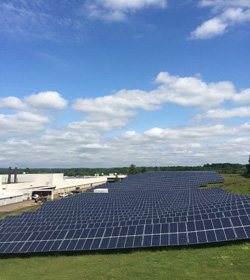ASSA ABLOY: An innovation and sustainability leader Recent tour of company’s HQ and solar farm provides glimpse into its culture and vision

By Paul Ragusa
Updated Wed December 20, 2017
NEW HAVEN, Conn.—For a company like ASSA ABLOY, it would be easy to rest on its laurels as a leader in the lock and intrusion business for nearly 25 years. But that is not the case with this international company that was formed in 1994 through the merger of ASSA in Sweden and Abloy in Finland. Since then, the company has grown from a regional entity into an international group with approximately 47,000 employees and annual sales of more than $8 billion.
 In addition to the continued innovations in the lock and mobile access arena, the company is leading in the area of sustainability, from the energy savings that can be attained with its products, to the solar energy farm (pictured) that helps power one of the company's two manufacturing plants based in Connecticut.
In addition to the continued innovations in the lock and mobile access arena, the company is leading in the area of sustainability, from the energy savings that can be attained with its products, to the solar energy farm (pictured) that helps power one of the company's two manufacturing plants based in Connecticut.
Martin Huddart, president of Access and Egress Hardware at ASSA ABLOY, told me during a recent visit to the company's U.S. headquarters based here, that there is a lot of pressure on manufacturers today to stay at the forefront of new technology, especially with the pace of change that is going on in the residential space over the past few years.
“What is interesting for us is the residential world is moving so fast that it is driving the commercial world at a faster pace,” Huddart said. “The implications for us as manufacturers, we have to do a better job of making our technology implementable and easier to use. I think we are doing that in the residential world but all of us on the manufacturing side need to do a better job of that on the commercial side as well.”
Huddart asked an important industry question: “With this new IoT world that we are now living in—and everyone enabling devices with sensors and the ability to communicate—what are the security implications?”
He pointed out that with 50 billion connected devices expected by 2020, four billion connected people, 25 million apps and 50 trillion GB of data, it is important to have products that not only solve problems but that also work seamlessly together in an overall smart ecosystem.
“My favorite definition of the Internet of Things is the infrastructure of the information society, and that phrase information society has a lot of connotations around behavior and how we live our lives,” he explained. “We were the first lock company to do IP-based locks, so we were the first company to put the lock on the network, and it challenged the paradigm.”
ASSA ABLOY, along with sister company HID Global, is also pushing the paradigm in the area of mobile access and mobile credentialing.
“Using the phone is the future—to be able see everything and control everything,” said Huddart. “The mobile credential is an option that will become more and more common in the future. Our sister company is HID, so it is fortunate to us that we have them spending a lot of time and money thinking about sticking an ID in your phones, which is every bit as secure, if not more, than an access card.”
With the way technology is moving, Huddart said that he is seeing a lot of future proofing going on in the commercial world today, especially with new construction. “So when we sell locks, many are buying Bluetooth capability, even though they haven't turned it on yet. Although they may only be using access cards right now, they are thinking ahead because they know they will eventually move on to that. Colleges and universities are a good example of this.”
He astutely pointed out that with all of the data that is being produced today, it isn't just about security anymore.
“There is this increased expectation that goes well beyond just the locks, including connectivity and mining data for insight—that is the future,” Huddart noted. “Consumers are drifting beyond traditional security into wanting insights into their homes and buildings. For example, detecting mechanical failure before it happens based on data analysis, machine learning or AI, which can detect anomalies, and start to be preventive. And we are moving toward building automation, where in the future the buildings will make decisions that people used to make. Are we ready for that?”
On the sustainability front, in addition to a solar farm that provides up to 50 percent of power for its manufacturing plant, ASSA ABLOY is showing how energy efficiency is a new dimension for access control.
“So, you think about your light bulbs, but do you think about that access control that is humming in the ceiling and consuming energy 24/7?” Huddart asked. “So we kind of ripped through our product portfolio—all of our products like our locks, strikes, mag locks and power supplies—and we've gone through them and we've created energy efficiency alternatives to our traditional components. So this portfolio of products on average is probably 90 percent more efficient than their older cousins that have been around for decades.”
ASSA ABLOY actively pursues transparency documents for many products, ensuring that builders, designers, specifiers, architects and others are confident in their ability to provide products that consider the product's entire life cycle impact. To this goal, ASSA ABLOY offers more than 100 products with Environmental Product Declarations (EPDs), which include a product's LCA (life cycle assessment) and serves as a way to quantify the product's environmental impact. The company also offers more than 20 products with Health Product Declarations (HPDs), which reports the content of a product along with its associated health and other related information, as well as more than 20 products with Declare labels, which serve as a way to disclose product ingredients, specifically those used for Living Building Challenge projects.
Looking forward, the company is planning to expand its solar farm and manufacturing footprint, in addition to doing research in the area of energy harvesting, which “is a big topic right now,” said Huddart. “We are also in beta testing for a solar-assisted smart lock, which can extend the life of that battery much longer than a year or two, depending on how much sunlight the door is getting.”
Comments